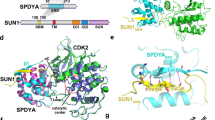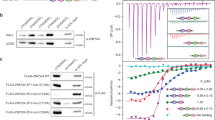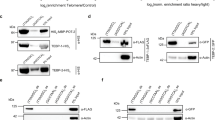Abstract
The alignment of homologous chromosomes during meiosis is essential for their recombination and segregation. Telomeres form and protect the ends of eukaryotic linear chromosomes, and are composed of tandem repeats of a simple DNA sequence and the proteins that bind to these repeats1,2,3. A role for telomeres in meiosis was suspected from observations of telomere clustering in meiotic cells4,5,6,7 and has now been supported experimentally by the dramatic rearrangement of telomere locations during premeiotic stages in fission yeast8,9. Here we show that the fission yeast telomere protein, Taz1 (ref. 10), is required for stable association between telomeres and spindle pole bodies during meiotic prophase. In the absence of Taz1, telomere clustering at the spindle pole bodies is disrupted, meiotic recombination is reduced, and both spore viability and the ability of zygotes to re-enter mitosis are impaired to a level that would be expected if chromosome segregation were occurring randomly. Such telomeric association mediated by telomere-specific proteins may also be important for proper chromosome alignment and recombination during meiosis in humans.
This is a preview of subscription content, access via your institution
Access options
Subscribe to this journal
Receive 51 print issues and online access
$199.00 per year
only $3.90 per issue
Buy this article
- Purchase on Springer Link
- Instant access to full article PDF
Prices may be subject to local taxes which are calculated during checkout



Similar content being viewed by others
References
Blackburn, E. H. & Greider, C. W. Telomeres (Cold Spring Harbor Laboratory Press, New York, 1995).
Greider, C. W. & Blackburn, E. H. Identification of a specific telomere terminal transferase activity in Tetrahymena extracts. Cell 43, 405–413 (1985).
Zakian, V. A. Telomeres: beginning to understand the end. Science 270, 1601–1607 (1995).
Loidl, J. The initiation of meiotic pairing: the cytological view. Genome 33, 759–778 (1990).
John, B. Meiosis. Dev. Cell Biol. Ser. 22(Cambridge University Press, Cambridge, 1990).
Scherthan, H., Bahler, J. & Kohli, J. Dynamics of chromosome organization and pairing during meiotic prophase in fission yeast. J. Cell Biol. 127, 273–285 (1994).
Dernburg, A. F., Sedat, J. W., Cande, W. Z. & Bass, H. W. in Telomeres 295–338 (Cold Spring Harbor Laboratory Press, New York, 1995).
Chikashige, Y. et al. Telomere-led premeiotic chromosome movement in fission yeast. Science 264, 270–273 (1994).
Chikashige, Y. et al. Meiotic nuclear reorganization: switching the position of centromeres and telomeres in the fission yeast Schizosaccharomyces pombe. EMBO J. 16, 193–202 (1997).
Cooper, J. P., Nimmo, E. R., Allshire, R. C. & Cech, T. R. Regulation of telomere length and function by a Myb-domain protein in fission yeast. Nature 385, 744–747 (1997).
Gottschling, D. E., Aparicio, O. M., Billington, B. L. & Zakian, V. A. Position effect at Saccharomyces cerevisiae telomeres: reversible repression of pol II transcription. Cell 63, 751–762 (1990).
Nimmo, E. R., Cranston, G. & Allshire, R. C. Telomere-associated chromosome breakage in fission yeast results in variegated expression of adjacent genes. EMBO J. 13, 3801–3811 (1994).
Bahler, J., Schuchert, P., Grimm, C. & Kohli, J. Synchronized meiosis and recombination in fission yeast: observations with pat1-114 diploid cells. Curr. Genet. 19, 445–451 (1991).
Shimanuki, M. et al. Anovel fission yeast gene, kms1+, is required for the formation of meiotic prophase-specific nuclear architecture. Mol. Gen. Genet. 254, 238–249 (1997).
Egel, R. Commitment to meiosis in fission yeast. Mol. Gen. Genet. 121, 277–285 (1973).
Watanabe, Y. & Yamamoto, M. S. pombe mei2+ encodes an RNA-binding protein essential for premeiotic DNA synthesis and meiosis I, which cooperates with a novel RNA species meiRNA. Cell 78, 487–498 (1994).
Gutz, H. Site-specific induction of gene conversion in Schizosaccharomyces pombe. Genetics 69, 317–337 (1971).
Chong, L. et al. Ahuman telomeric protein. Science 270, 1663–1667 (1995).
van Steensel, B. & de Lange, T. Control of telomere length by the human telomeric protein TRF1. Nature 385, 740–743 (1997).
Moreno, S., Klar, A. J. S. & Nurse, P. Molecular genetic analysis of fission yeast Schizosaccharomyces pombe. Meth. Enzymol. 194, 795–823 (1991).
Gutz, H., Heslot, H., Leupold, U. & Loprieno, N. in Handbook of Genetics 211–287 (Plenum, New York, 1974).
Funabiki, H., Hagan, I., Uzawa, S. & Yanagida, M. Cell cycle specific positioning and clustering of centromeres and telomeres in fission yeast. J. Cell Biol. 121, 961–976 (1993).
Uzawa, S. & Yanagida, M. Visualization of centromeric and nucleolar DNA in fission yeast by fluorescence in situ hybridization. J. Cell Sci. 101, 267–275 (1992).
Hagan, I. & Yanagida, M. The product of the spindle formation gene sad1+ associates with the fission yeast spindle pole body and is essential for viability. J. Cell Biol. 129, 1033–1047 (1995).
Toda, T., Nakaseko, Y., Niwa, O. & Yanagida, M. Mapping of rRNA genes by integration of hybrid plasmids in Schizosaccharomyces pombe. Curr. Genet. 8, 93–97 (1984).
Chikashige, Y. et al. Composite motifs and repeat symmetry in Schizosaccharomyces pombe centromeres: direct analysis by integration of NotI restriction sites. Cell 57, 739–751 (1989).
Acknowledgements
We thank all the members of our laboratory for discussion, and particularly J. Hayles, J. Mata and K.Sawin for help and advice, K. Ekwall for cosmids, and I. Hagan for anti-Sad1 antibody. J.P.C. was supported by an EMBO fellowship and Y. W. was supported by a JSPS fellowship.
Author information
Authors and Affiliations
Corresponding author
Rights and permissions
About this article
Cite this article
Cooper, J., Watanabe, Y. & Nurse, P. Fission yeast Taz1 protein is required for meiotic telomere clustering and recombination. Nature 392, 828–831 (1998). https://doi.org/10.1038/33947
Received:
Accepted:
Published:
Issue Date:
DOI: https://doi.org/10.1038/33947
This article is cited by
-
Centromeres are dismantled by foundational meiotic proteins Spo11 and Rec8
Nature (2021)
-
The TERB1-TERB2-MAJIN complex of mouse meiotic telomeres dates back to the common ancestor of metazoans
BMC Evolutionary Biology (2020)
-
Phase separation drives pairing of homologous chromosomes
Current Genetics (2020)
-
Structure of the fission yeast S. pombe telomeric Tpz1-Poz1-Rap1 complex
Cell Research (2017)
-
Position matters: multiple functions of LINC-dependent chromosome positioning during meiosis
Current Genetics (2017)
Comments
By submitting a comment you agree to abide by our Terms and Community Guidelines. If you find something abusive or that does not comply with our terms or guidelines please flag it as inappropriate.



